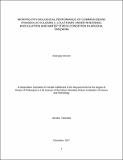| dc.description.abstract | The aim of this study was to identify common bean cultivars which can grow/yield better under rhizobial inoculation and at limited water condition. To attain the goal, two seasons field experiment and one season screen house experiment were conducted at Agricultural Seed Agency (ASA) in Arusha Tanzania in the year 2014 /2015 and 2016. The experiment was a split-split plot with three replications, two levels of rhizobia, two stress levels and five cultivars of P. vulgaris (L.) (KAT B9, KAT B1, F9 Kidney Selection, F8 Drought line and JESCA). Stress periods of 10 days were imposed at vegetative and flowering stages of plant growth. Results showed that proline content was high in inoculated and water stressed plants. Concentrations of flavonoids and anthocyanins were higher in non-inoculated water stressed treatments. Leaf chlorophyll content, relative leaf water content and electrolyte leakage were higher in rhizobial inoculated and non-water stressed treatments. The nutrients uptake was higher in rhizobial inoculation and non-water stressed treatments. Rhizobial inoculation significantly increased growth parameters and seed yields while water stress significantly reduced growth parameters at both growth stages. F8 Drought Line and JESCA varieties significantly recorded higher proline content in field experiment and KAT B1 in the screen house experiment. Varieties F8 Drought line, JESCA and F9 Kidney Selection significantly recorded higher flavonoids and anthocyanins content in both experiment. Leaf chlorophyll content was significantly higher in F9 Kidney Selection and KAT B1 than in F8 Drought Line and JESCA. Cultivars F9 Kidney Selection, F8 Drought Line and JESCA had significantly higher relative leaf water content than other cultivars. However, varieties KAT B9 and KAT B1 significantly increased percentage in electrolyte leakage.Varieties F9 Kidney Selection, F8 Drought Line and JESCA significantly recorded higher uptake of N, P, K, Ca and Mg. Varieties F9 Kidney Selection, F8 Drought Line and JESCA had significantly superior measurements reflected in increased plant height, shoot and root dry weight and seed yields. Significant interactions were observed between rhizobial inoculation, water stress and bean varieties. Cultivars F9 Kidney Selection, F8 Drought line, JESCA and KAT B1 showed highest level of tolerance against the water stress. With these observations, cultivars F9 Kidney Selection, F8 Drought line, JESCA and KAT B1 can be promoted for production especially in drought prone areas. | en_US |

